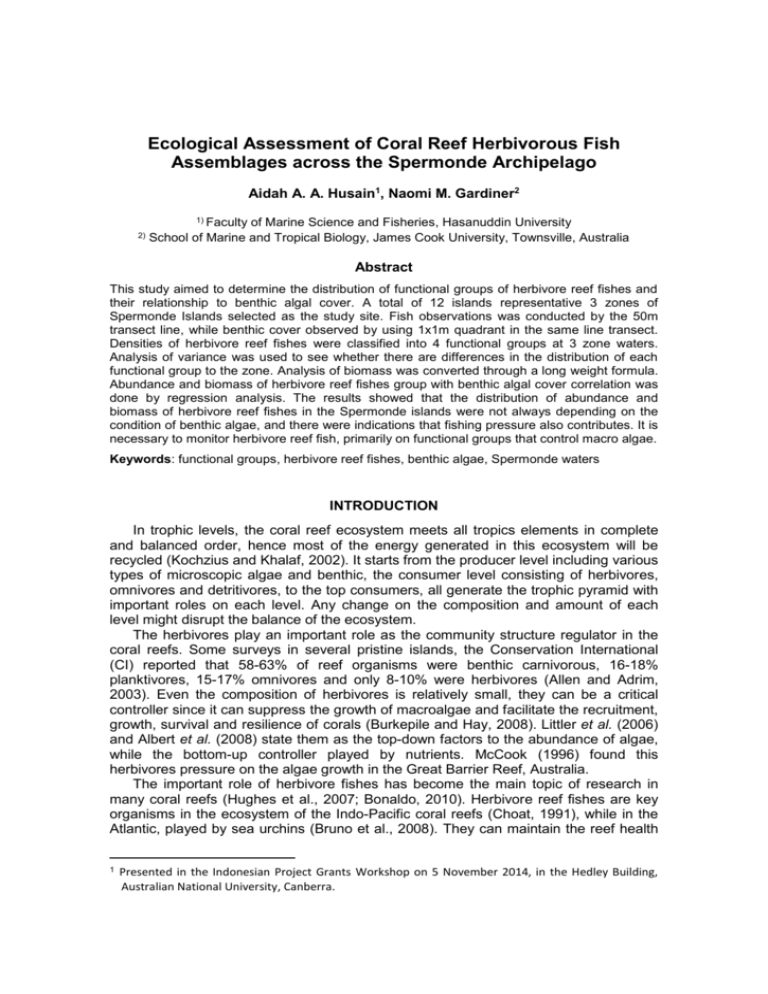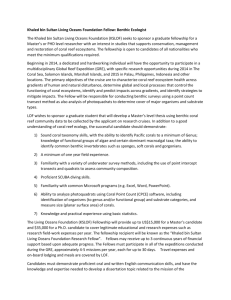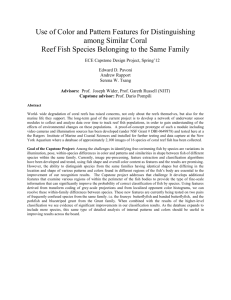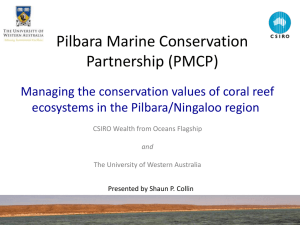View/Open - Hasanuddin University
advertisement

Ecological Assessment of Coral Reef Herbivorous Fish Assemblages across the Spermonde Archipelago Aidah A. A. Husain1, Naomi M. Gardiner2 1) Faculty 2) of Marine Science and Fisheries, Hasanuddin University School of Marine and Tropical Biology, James Cook University, Townsville, Australia Abstract This study aimed to determine the distribution of functional groups of herbivore reef fishes and their relationship to benthic algal cover. A total of 12 islands representative 3 zones of Spermonde Islands selected as the study site. Fish observations was conducted by the 50m transect line, while benthic cover observed by using 1x1m quadrant in the same line transect. Densities of herbivore reef fishes were classified into 4 functional groups at 3 zone waters. Analysis of variance was used to see whether there are differences in the distribution of each functional group to the zone. Analysis of biomass was converted through a long weight formula. Abundance and biomass of herbivore reef fishes group with benthic algal cover correlation was done by regression analysis. The results showed that the distribution of abundance and biomass of herbivore reef fishes in the Spermonde islands were not always depending on the condition of benthic algae, and there were indications that fishing pressure also contributes. It is necessary to monitor herbivore reef fish, primarily on functional groups that control macro algae. Keywords: functional groups, herbivore reef fishes, benthic algae, Spermonde waters INTRODUCTION In trophic levels, the coral reef ecosystem meets all tropics elements in complete and balanced order, hence most of the energy generated in this ecosystem will be recycled (Kochzius and Khalaf, 2002). It starts from the producer level including various types of microscopic algae and benthic, the consumer level consisting of herbivores, omnivores and detritivores, to the top consumers, all generate the trophic pyramid with important roles on each level. Any change on the composition and amount of each level might disrupt the balance of the ecosystem. The herbivores play an important role as the community structure regulator in the coral reefs. Some surveys in several pristine islands, the Conservation International (CI) reported that 58-63% of reef organisms were benthic carnivorous, 16-18% planktivores, 15-17% omnivores and only 8-10% were herbivores (Allen and Adrim, 2003). Even the composition of herbivores is relatively small, they can be a critical controller since it can suppress the growth of macroalgae and facilitate the recruitment, growth, survival and resilience of corals (Burkepile and Hay, 2008). Littler et al. (2006) and Albert et al. (2008) state them as the top-down factors to the abundance of algae, while the bottom-up controller played by nutrients. McCook (1996) found this herbivores pressure on the algae growth in the Great Barrier Reef, Australia. The important role of herbivore fishes has become the main topic of research in many coral reefs (Hughes et al., 2007; Bonaldo, 2010). Herbivore reef fishes are key organisms in the ecosystem of the Indo-Pacific coral reefs (Choat, 1991), while in the Atlantic, played by sea urchins (Bruno et al., 2008). They can maintain the reef health 1 Presented in the Indonesian Project Grants Workshop on 5 November 2014, in the Hedley Building, Australian National University, Canberra. which effect the benthic community structure (Vincent et al., 2011). In the waters that severe with overfishing, abundant benthic algal groups are usually found, and it is generally due to the lack of herbivore fishes (McClanahan et al., 1996). The common family of herbivore fishes found in coral reefs are triggerfish (Acanthuridae), parrotfish (Scaridae), rabbitfish (Siganidae), rudderfish (Kyphosidae) and batfish (Ephippidae). Both Acanthuridae and Scaridae have greater tasks in limiting algae growth, as well as cleaning the substrates to provide coral planula larvae to attach and grow (Bellwood et al., 2004; Mumby et al., 2006). The grazing intensity is high enough to inhibit the growth of algae in covering the surface of corals (Bellwood et al., 2004). The number of herbivore fishes are quite enomerous and various, however from previous studies, Green and Bellwood (2009) has summarized these fishes it into several functional groups according to their roles based on feeding habit, food habit, and their impact on the substrate. Functional group is a group of species that have similar functions, regardless of the proximity of taxonomy (Steneck and Dethier, 1994). For reef fish, the functional group is generally synonymous with a collection of species from different trophic levels in the food chain (e.g. predators and herbivor), which reflects their role in main energy flow in coral reefs (Bellwood et al., 2004). This grouping is important in understanding the role of herbivore fishes in the coral reef ecosystem and build up ecological models to examine the herbivore impact in reef communities (Burkepile and Hay, 2011). Green and Bellwood (2009) has divided the these herbivore fishes into four functional groups, i.e. scrapers/small excavators, large excavators/ bioeroders, grazers/detritivores, and browser. In recent years, Spermonde Islands waters have suffered with high fishing pressure and this in turn affect species diversity and abundance (Jompa et al., 2006), especially on herbivore reef fishes and the algae as their food. The protection of reef fish herbivor is needed in order to maintain the health of coral reefs, so the research on reef fish herbivor based functional groups is necessary to look at the distribution of functional groups herbivor reef fish and benthic algal cover conjunction with several islands in Spermonde Islands. METHODS Sites This research was conducted in the waters of the coral reefs in 12 of over 100 islands scattered Spermonde Islands in March 2014. Selection of the island by the zoning by de Klerk (1983), which divides the four zones based on topography and geomorphology. Furthermore, zoning was modified by Faisal (2012) into 3 zones, through eutrophication modeling directly related to the presence of benthic algae, which further relates to the presence of biota herbivor. Zone I consists of 3 islands (Lae-lae, Laiya, Salemo), Zone II consists of 4 islands (Barranglompo, Bontosua, Kodingarenglompo, Samatellulompo) and Zone III consists of 5 islands (Lanyukang, Lumu-Lumu, Reang-Reang, Saranti , Tambakulu). Herbivore Reef Fishes Observations of reef fish herbivor performed using a 50-meter transect line, with repeat 3 times, at a depth of 3-6 meters, mounted parallel to the coastline following the instructions English et al. (1994). Observations were made of the number and types of reef fish herbivor, as well as estimates of the total length of each individual category of reef fish herbivor, by setting the value of the midpoint in each category (Table 1), in an area of 2.5 meters to the left and right (a total of 5 meters). Once converted distance measurement, in turn, used to estimate broad transect abundance units (ind/250m2). As for biomass estimation is done by converting the long relationship the weight of each species of fish in the Green and Bellwood (2009) which is then converted to units of kg / ha. Table 1. The midpoint of each category from total length of herbivore fishes (Green and Bellwood, 2009). Category 1 2 3 4 5 6 7 8 Size 5 - < 7.5 cm 7.5 - < 10 cm 10 - < 15 cm 15 - < 20 cm 20 - < 25 cm 25 - < 30 cm 30 - < 35 cm 35 - < 40 cm Midpoint 6.25 cm 8.7 cm 12.5 cm 17.5 cm 22.5 cm 27.5 cm 32.5 cm 37.5 cm Benthic Algae Coverage Observations cover the overall benthic done using quadrant 1x1M on transect lines previously installed for observation herbivor reef fish. In these transects, data collection percentage composition of benthic algal cover, live coral, dead coral, sponges and other organisms as well as the substrate by the method of PIT (point intercept transect) every 10 meters on the transect line to follow the development of LIPI (2008). Data Analysis Abundance of reef fish herbivor translated into 4 functional groups on the 3 zone waters. Analysis of variance is used to see if there are differences in the distribution of abundance of each functional group to the zone. Similarly, analysis of biomass, for which data is converted through a long formula weight of each species with different constants refer to Green and Bellwood (2009). Furthermore, to see the relationship of abundance and biomass of reef fish groups herbivor with benthic algal cover performed by regression correlation analysis. RESULTS Herbivor reef fishes observed during the study in Zone I, II and III consists of 48 species and one individual, which is divided into four functional groups herbivor: browsers, grazers, excavators and scrapers (Figure 1). Browsers: Acanthurus lineatus (TL 28cm) Grazers: Siganus vulpinus (TL 19cm) Excavators: Chlorurus sordidus (TL 20cm) Scrapers: Scarus ghobban (TL 20cm) Figure 1. Some species found of each functional group species. Abundance and Biomass The distance between the zones with the mainland tend to influence, based on the average abundance of reef fish herbivor increased from Zone I to Zone III (Figure 2). Nevertheless, the results of the analysis of variance showed no significant difference from the average abundance of fish herbivor between zones (P = 0.0692) (Table 2). Figure 2. Distribution of average abundance and biomass of herbivore fishes in each zone. Average biomass of reef fish herbivor showed varying trends. Average biomass from Zone I to Zone II increased almost 2-fold, but then again decreases when heading to Zone III. Although the average abundance of fish in Zone III herbivor most, but low biomass. This indicates that the distribution of fish herbivor in the outer zone is mostly small. Nevertheless, the results of the analysis of variance showed no differences remained between the zones to the overall biomass (P = 0.3007) (Table 2). Table 2. Summary results of the analysis of variance or t-test, and further result on significant difference by Tukey's Post-Hoc test. Variable df F T P Abundance Browsers 2 0.1597 0.8850 Grazers 2 2.811 0.1126 Excavators 7 Scrapers 2 2.646 0.1248 Total 2 2.849 0.0692 Browsers 2 0.6093 0.5672 Grazers 2 0.4532 0.6493 Excavators 7 Scrapers 2 0.06768 0.935 Total 2 1.226 0.3007 Zone I 2 0.6843 0.5461 * Zone II 3 3.647 0.0446 * Zone III 3 4.589 0.0168 Zone I 2 0.2837 0.7644 Zone II 3 0.8376 0.4989 Zone III 3 0.5929 0.6286 0.3406 0.7434 Biomass 2.277 0.0569 Abundance Biomass Post-hoc Tukey Test (P<0.05) Mean Diff. q 95% CI of diff Abundance Zone II Browsers vs Scrapers -21.17 4.55 -40.70 to -1.632 Zone III Browser vs Scrapers -20.73 5.117 -37.13 to -4.340 The results of the analysis of variance test also remains showed no difference herbivor abundance and biomass of fish between the zones for each functional group (browsers, grazers, excavators and scrapers) (Table 2). Although descriptive, look to the differences on almost all histograms, except the variable "Biomass-Scrapers" that looks almost the same (Figure 3). Ledlie et al. (2007) previously found no particular tendency for both abundance and biomass among research locations. However, the abundance of functional groups browsers and scrapers showed a marked difference in Zone II (P = 0.0446) and Zone III (P = 0.0168) (Table 2, Figure 4). Figure 3. Average abundance and biomass of each functional group herbivor fish in each zone. Figure 4. Average abundance and biomass of each zone for each functional group herbivor fish. Herbivore Fish Biomass and Benthic Algae Coverage 150.00 60.00 120.00 50.00 40.00 90.00 30.00 60.00 20.00 30.00 10.00 0.00 0.00 Zona Zone II Zona Zone IIII Zona III Zone III Avergae of Benthic Algae Cover (%) Average of Herbivore Fish Biomass (kg/ha) Average percentage of the benthic algal cover showed the lowest value in Zone II, this is different to the average biomass of reef fish are generally higher herbivor in Zone II (Figure 5). Regression model between each functional group by percentage of benthic algal cover showed a weak correlation, indicated by low R2 values (0007-0263) (Table 3). This indicates that the benthic algal cover is controlled by the presence of fish herbivor, although in this study did not show a significant role. Browsers Excavators Grazers Scrapers Alga Bentik Figure 5. Average biomass of herbivore fishes to average percentage cover of benthic algae. Table 3. Regression analysis result between the biomass of each functional groups of fish and percentage of benthic algal coverage. Equation R2 Browsers y = -0.068x + 41.04 0.007 Grazers y = -0.158x + 49.20 0.263 Excavators y = -0.137x + 44.51 0.112 Scrapers y = -0.079x + 45.43 0.136 Fungsional Groups DISCUSSION Abundance and distribution of reef fish herbivor can vary spatially along the coastline, or based on depth, as well as among a variety of reef habitat conditions (Nemeth and Appeldoorn, 2009). Herbivor reef fish distribution pattern generally depends among others on the number of individuals and biomass, which have an impact on changes in benthic (Ledlie et al., 2007). The distribution of functional groups of reef fish herbivor descriptively show different abundance and biomass. In Zone I, which is the area near the mainland, found the average abundance and biomass were the lowest, but it was also found that the percentage of algal cover the most high. Russ (2003) found a significant positive correlation between the productivity of algal biomass grazers in the Great Barrier Reef. However, some of the results of other studies in which it gives a picture of the areas with high benthic algal cover there is little evidence to indicate that both the number and biomass of reef fish herbivor increases with an increase in algal turf (Ledlie et al., 2007). It is actually related to the types of the algae itself, which is divided into several functional groups based on anatomical and morphological characteristics (Steneck and Dethier, 1994) and growth form (Diaz-Pullido and McCook, 2008). In Zone I generally present with a group of macro algae are generally canopy size> 10 mm, which at this stage most of the types of macro algae have been less desirable for consumption by the various functional groups of fish herbivor. Only a few species of grazers and browsers that group can still consume the type of macro algae (Green and Bellwood, 2009). While in Zone II, it is generally found the highest abundance and biomass, but with low benthic algal cover. This suggests that predation activity herbivor fairly intensive, because algal species composition bentiknya still favored, which generally is a type of benthic algal canopy size generally <10 mm (Diaz-Pullido and McCook, 2008). As in Zone III, although the highest abundance, but lower biomass, and percent cover of algae that is also low. This indicates there is still a high intensity of predation by fish herbivor small. In general, groups of scrapers which are found in this zone, while browsers and grazers especially large been reduced. Possibility of fishing pressure on the fish herbivor larger ones could be one cause of reduced fish biomass in this zone. The arrest of a high activity made possible due the location of these islands from the mainland, so there is no special control and handling of related parties. CONCLUSION Distribution of abundance and biomass of fish herbivor functional groups showed no significant differences between the zones. However, their abundance showed differences between the functional groups of reef fish herbivor in each zone, especially in the middle zone and outer zone. Herbivor reef fish functional groups contribute to the control of benthic algal cover. It is necessary for the monitoring of reef fish herbivor primarily on functional groups that play a role in the control of macro-algae in maintaining the health of coral reef ecosystems. Acknowledgements I would like to thank Dr. Ahmad Faisal, Arham, and Opay for their considerable assitance during field works, Arniati M.Si for her underwater camera and some equipments, and Dr. Nurliah Buhari for data processing. REFERENCES Albert, S., J. Udy, and I.R. Tibbetts (2008). Responses of algal communities to gradients in herbivore biomass and water quality in Marovo Lagoon, Solomon Islands. Coral Reefs, 27: 73–82. Allen, G. and M. Adrim (2003). Coral reef fishes of Indonesia. Zoological Studies, 42(1): 1–72. Bellwood, D.R., T.P. Hughes, C. Folke, and M. Nyström (2004). Confronting the coral reef crisis. Nature, 429: 827–833. Bonaldo, R.M., J.P. Krajewski and D.R. Bellwood (2011). Relative impact of parrotfish grazing scars on massive Porites corals at Lizard Island, Great Barrier Reef. Marine Ecology Progress Series, 423: 223–233. Bruno, J.F., H. Sweatman, W.F. Precht, E.R. SELIG, and V.G.W. Schutte (2009). Assessing evidence of phase shifts from coral to macroalgal dominance on coral reefs. Ecology, 90(6): 1478–1484. Burkepile, D.E. and M.E. Hay (2008). Herbivore species richness and feeding complementarity affect community structure and function on a coral reef. PNAS, 105(42): 16201–16206. Burkepile, D.E. and M.E. Hay (2011). Feeding complementarity versus redundancy among herbivorous fishes on a Caribbean reef. Coral Reefs, 30: 351–362. Choat, J.H. (1991). The biology of herbivorous fishes on coral reef. In: Sale, P.F. (ed) The Ecology of Fishes on Coral Reefs. Academic Press Inc., California USA. Pp 120-155. deKlerk, L.G. (1983). Zeespiegels, riffen en kustvlakten in Zuidwest Sulawesi, Indonesie, een morphogenetischbodemkundige studie. PhD thesis, University of Utrecht, The Netherlands. Diaz-Pulido, G. and L.J. McCook (2008). Macroalgae (Seaweeds). In: Chin, A. (ed) The State of the Great Barrier Reef On-line. Great Barrier Reef Marine Park Authority, Townsville. http://www.gbrmpa.gov.au/corp_site/info_services/ publications/sotr/downloads/SORR_Macroalgae.pdf (Akses: 23 Juli 2008). English, S., C. Wilkinson, and V. Baker (1994). Survey Manual for Tropical Marine Resources. Australian Institute of Marine Science, Townsville. Faizal, A. (2012). Dinamika spasio-temporal pengaruh eutrofikasi dan sedimentasi terhadap degradasi terumbu karang. Disertasi. Program Pasca Sarjana Universitas Hasanuddin, Makassar. 270 hal. Green, A.L. and D.R. Bellwood (2009). Monitoring functional groups of herbivorous reef fishes as indicators of coral reef resilience – A practical guide for coral reef managers in the Asia Pacific Region. IUCN Working Group on Climate Change and Coral Reefs. IUCN, Gland, Switzerland. 70p. Hughes, T.P., D.R. Bellwood, C.S. Folke, L.J. McCook, and J.M. Pandolfi (2007). No-take areas, herbivory and coral reef resilience. Trends in Ecology and Evolution, 22(1): 1–3. Jompa, J. & L.J. McCook (2002). The effects of nutrients and herbivory on competition between a hard coral (Porites cylindrica) and a brown alga (Lobophora variegata). Limnol. Oceanogr., 47(2): 527–534. Jompa, J., A.A.A. Husain, M. Litaay, D. Yanuarita, and C. Richter (2006). Anthropogenic and natural stresses on coral reefs around Spermonde Archipelago: management challenges for conservation. Manuscript presented at the 6 th European Meeting of the International Society for Coral Reef Studies, Bremen, Germany. Khalaf, M.A. and M. Kochzius (2002). Community structure and biogeography of shore fishes in the Gulf of Aqaba, Red Sea. Helgol Mar Res, 55: 252–284. Ledlie, M.H., N.A.J. Graham, J.C. Bythell, S.K. Wilson, S. Jennings, N.V.C. Polunin, and J. Hardcastle (2007). Phase shifts and the role of herbivory in the resilience of coral reefs. Coral Reefs, 26: 641–653. Lembaga Ilmu Pengetahuan Indonesia (LIPI) (2008). Baseline Data Daerah Perlindungan Laut Kabupaten Pangkep. LIPI-COREMAP II, Jakarta. Littler, M.M. and D.S. Littler (2006). Assessment of coral reefs using herbivory/nutrient assays and indicator groups of benthic primary producers: a critical synthesis, proposed protocols, and critique of management strategies. Aquatic Conserv: Mar. Freshw. Ecosyst. McCook, L.J. (1996). Effects of herbivores and water quality on Sargassum distribution on the central Great Barrier Reef: cross-shelf transplant. Marine Ecology Progress Series, 139: 179–192. Mumby, P.J., C.P. Dahlgren, A.R. Harborne, C.V. Kappel, F. Micheli, D.R. Brumbaugh, K.E. Holmes, J.M. Mendes, K. Broad, and J.N. Sanchirico (2006). Fishing, trophic cascades, and the process of grazing on coral reefs. Science, 311: 98–101. Nemeth, M. and R. Appeldoorn (2009). The distribution of herbivorous coral reef fishes within fore-reef habitats: the role of depth, light and rugosity. Caribbean Journal Science, 45(2-3): 247–253. Russ, G.R. (2003). Grazer biomass correlates more strongly with production than with biomass of algal turfs on a coral reef. Coral Reefs, 22: 63–67. Steneck, R.S. and M.N. Dethier (1994). A functional group approach to the structure of algaldominated communties. Oikos, 69: 476–498. Vincent, I.V., C.M. Hincksman, I.R. Tibbetts and A. Harris (2011). Biomass and abundance of herbivorous fishes on coral reefs off Andavadoaka, Western Madagascar. Western Indian Ocean J. Mar. Sci., 10(1): 83–99. Wismer, S., A.S. Hoey, and D.R. Bellwood (2009). Cross-shelf benthic community structure on the Great Barrier Reef: relationships between macroalgal cover and herbivore biomass. Marine Ecology Progress Series, 376: 45–54.







